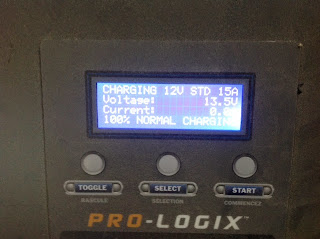The van starts fine with no boost needed in the parking lot so the battery is not dead at this time. I want to verify we have a good battery so a battery test is needed. I've mentioned before I like to use the tester that measures internal plate resistance so I need to disconnect the battery cables at the posts. Since this battery is not dead the KAM Keep Alive Memory or the engine computer's learned memory should be saved. If I disconnect the cables the KAM will be cleared so I'll connect a memory saver to the diagnostic connector. These devices keep the engine computer powered while the battery is disconnected.
This battery tests good but is only at 70% charge. I know the battery was discharged and jumped so it hasn't been fully charged. I'll need to put the battery on the charger.
Getting a full charge can take several hours so I'll install a known good battery from my stock and continue testing while the battery comes up. After the new battery is connected I can disconnect the memory saver.
After allowing for the modules to time out I check battery draw, which is within specs.
I need to test the alternator. I put the voltmeter on the battery and measure battery voltage before starting the engine. I'll compare that reading to the one I get with the engine running.
I like to use a simple voltmeter initially and only go further when I see a reason for more testing. Here I see a need for more testing. I notice the meter is showing a charge and is in the "ok" zone but not by much. There is no load on the system and the engine is at idle. That's not looking like a good alternator output. I turn the lights on and the alternator isn't keeping up. I'd like to rev the engine and watch the meter but I can't do that from under the hood on this van.
I need deeper testing and I need to be in the driver's seat where I can rev the engine as needed. I have a tool perfect for the situation. A wireless tester that connects to the battery yet lets me use a wire free remote to see what's going on while I'm in the driver seat. This alternator is bad.
I replaced the alternator and did another test with the voltmeter and with the tester.
After a few hours the battery is fully charged.
I again use the memory saver re-install the original battery. I turn the headlights on and crank the engine a few times to get rid of the surface charge, then its time to disconnect the battery for testing.
The battery tests good. The alternator tests good. The magic is done.
Kenneth Hayes
G&G Auto Repair


















No comments:
Post a Comment